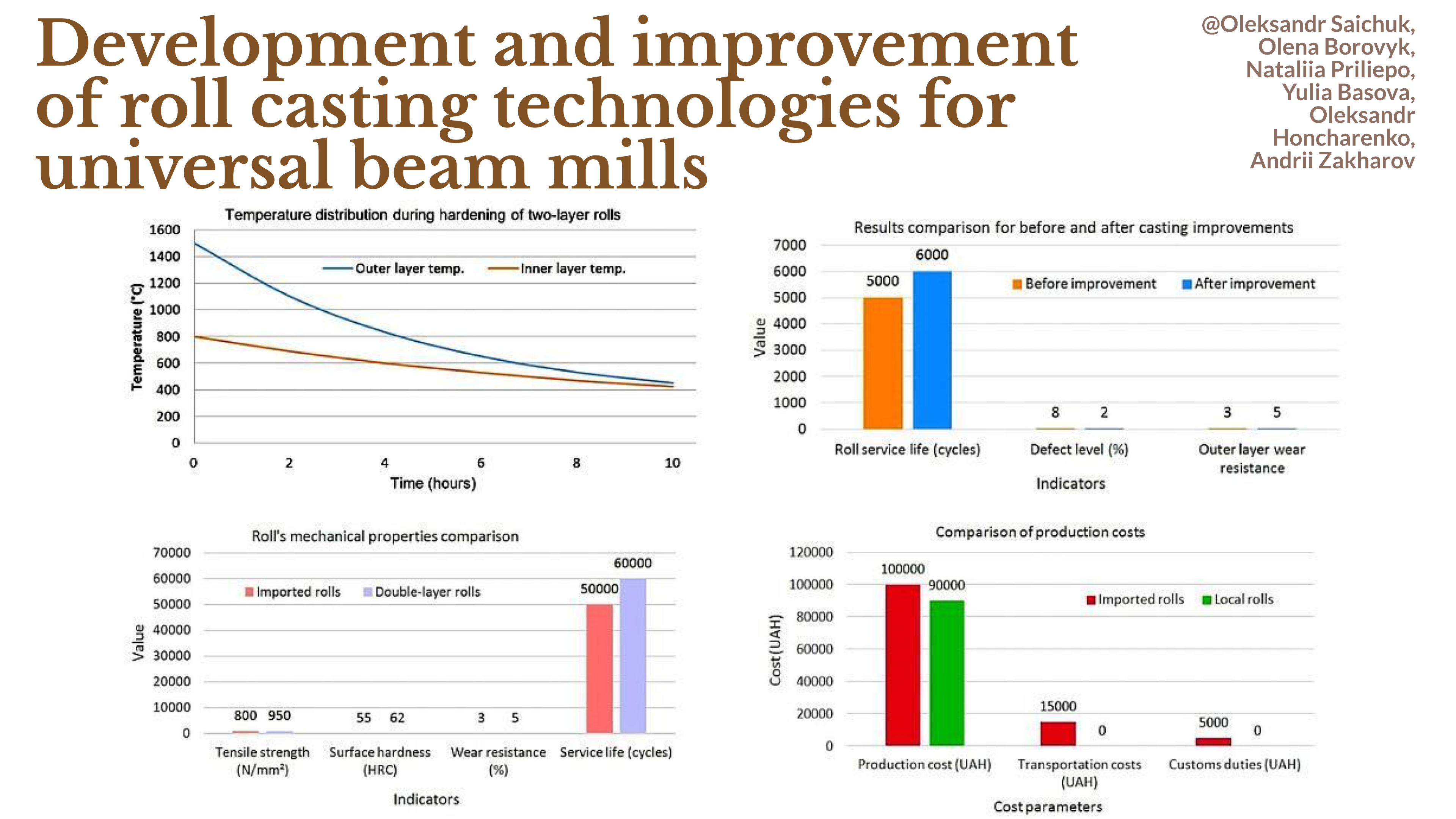Розробка та удосконалення технологій лиття валків для універсальних балкових станів
DOI:
https://doi.org/10.15587/2706-5448.2024.320381Ключові слова:
універсальні балкові стани, двошарові валки, технології лиття, термічна обробка, бейнітно-мартенситна матрицяАнотація
Об'єктом дослідження є технології лиття двошарових валків для універсальних балкових станів (УБС). Вони є критично важливими компонентами металургійної промисловості, що забезпечують виробництво балок, профілів та інших конструктивних елементів, які широко застосовуються у будівництві, машинобудуванні, транспорті, енергетиці та інших галузях. Розробка інноваційних підходів до виготовлення валків є стратегічно важливою для зміцнення виробничого потенціалу України. Оскільки одним з найбільш проблемних місць є залежність від імпортних валків, яка призводить до значних економічних втрат, логістичних ризиків та обмеження технологічної незалежності країни. Існуючі вітчизняні технології не завжди дозволяють досягти необхідних експлуатаційних характеристик, таких як зносостійкість, термостійкість та довговічність, що ускладнює конкурентоспроможність продукції на міжнародному ринку.
Отримано інноваційну технологію виготовлення двошарових валків, яка включає застосування стаціонарних форм для лиття, використання бейнітно-мартенситної структури зовнішнього шару та оптимізацію температурних режимів. Це забезпечує високу твердість, термостійкість і зносостійкість зовнішнього шару. Внутрішній шар, виготовлений із матеріалів з високою пластичністю, компенсує залишкові напруження та покращує структурну стабільність. Застосування легуючих елементів (нікель, молібден, мідь) у поєднанні з математичним моделюванням температурних полів дозволило знизити кількість дефектів структури, таких як пористість і відшарування, а також забезпечити рівномірне з'єднання шарів. Це пов'язано з тим, що запропонована технологія поєднує сучасні підходи до легування, оптимізації термічної обробки та використання високотехнологічного моделювання температурних режимів під час лиття. Особливістю є адаптація матеріалів до умов високих механічних і термічних навантажень, а також інноваційний дизайн форми лиття, що забезпечує високий рівень адгезії між шарами та знижує ризик утворення дефектів. Завдяки цьому забезпечується можливість ефективної експлуатації валків у важких умовах роботи, включаючи високі механічні та термічні навантаження. У порівнянні з аналогічними відомими рішеннями, запропонована технологія дозволяє збільшити термін служби валків на 20–25 %, знизити витрати на ремонт та обслуговування на 15–20 %, а також підвищити ефективність виробничих процесів завдяки зменшенню кількості зупинок обладнання.
Посилання
- Vlasenko, T., Glowacki, S., Vlasovets, V., Hutsol, T., Nurek, T., Lyktei, V., Efremenko, V., Khrunyk, Y. (2024). Increasing Exploitation Durability of Two-Layer Cast Mill Rolls and Assessment of the Applicability of the XGBoost Machine Learning Method to Manage Their Quality. Materials, 17 (13), 3231. https://doi.org/10.3390/ma17133231
- Samokhval, V., Stasko, Y., Vasyliev, O. (2023). To the development of statistical models of wear rolls of long prodacts mills. Collection of Scholarly Papers of Dniprovsk State Technical University (Technical Sciences), 2 (43), 56–66. https://doi.org/10.31319/2519-2884.43.2023.5
- Bazarova, K. V. (2019). Udoskonalennya tekhnolohiyi ta obladnannya dlya prokatky dvotavrovykh balok na osnovi analizu formozminy metalu v rozriznykh kalibrakh. [Extended abstract of PhD thesis; Donbaska Derzhavna Mashinobudіvna Akademіia]. Available at: http://www.dgma.donetsk.ua/docs/nauka/12.105.01/bazarova/avtoreferat%20%20Bazarova%2007%2011%2019.pdf
- Ivanova, L. Kh., Bilyy, O. P., Osypenko, I. O. (2017). Vplyv sposobu lyttya prokatnykh valkiv na riven zalyshkovykh napruzhen u nykh. Visnyk Donbaskoyi derzhavnoyi mashynobudivnoyi akademiyi, 2 (41), 34–36. Available at: http://www.dgma.donetsk.ua/science_public/ddma/Herald_2(41)_2017/article/8.pdf
- Hlushkova, D., Volchuk, V., Marynenko, S. (2024). Optimization of mechanical properties of rolling rolls using multiparametric technologies. Applied Mechanics. Kyiv, 350–352. Available at: https://elartu.tntu.edu.ua/handle/lib/45541
- Arias-Ferreiro, G., Ares-Pernas, A., Dopico-García, M. S., Lasagabáster-Latorre, A., Abad, M.-J. (2020). Photocured conductive PANI/acrylate composites for digital light processing. Influence of HDODA crosslinker in rheological and physicochemical properties. European Polymer Journal, 136, 109887. https://doi.org/10.1016/j.eurpolymj.2020.109887
- Mohamed Nishath, P., Sekar, K. (2020). Boulevard for Effective Consumption of Power and Energy in Friction Stir Welding. Materials Today: Proceedings, 22, 1489–1498. https://doi.org/10.1016/j.matpr.2020.02.066
- Wang, Y. F., Hu, S. Y., Tian, Z. Q., Cheng, G. X. (2021). Corrigendum to “Quantitative assessment of the hydrogen induced cracking for 2.25Cr-1Mo-0.25V steel under electrochemical charging conditions”. Engineering Failure Analysis, 126, 105425. https://doi.org/10.1016/j.engfailanal.2021.105425
- Startt, J., Kustas, A., Pegues, J., Yang, P., Dingreville, R. (2022). Compositional effects on the mechanical and thermal properties of MoNbTaTi refractory complex concentrated alloys. Materials & Design, 213, 110311. https://doi.org/10.1016/j.matdes.2021.110311
- Atrens, A., Dietzel, W., Bala Srinivasan, P., Winzer, N., Bobby Kannan, M. (2011). Stress corrosion cracking (SCC) of magnesium alloys. Stress Corrosion Cracking. Woodhead Publishing, 341–380. https://doi.org/10.1533/9780857093769.3.341
- Mishchenko, A. V. (2020). Development of the ideology of calibrations of the tool for cold rolling of pipes from alloys based on titanium. Metal and Casting of Ukraine, 317-319 (10-12), 64–73. https://doi.org/10.15407/steelcast2019.10.064
- Schuppener, J., Benito, S., Weber, S. (2024). Correction: Increasing Energy Efficiency by Optimizing Heat Treatment Parameters for High-Alloyed Tool Steels. Journal of Materials Engineering and Performance, 33 (18), 9641–9641. https://doi.org/10.1007/s11665-024-09673-3
- Noha, V. O. (2024). Manufacturing castings from heat-resistant alloys for critical part. Casting Processes, 155 (1), 48–57. https://doi.org/10.15407/plit2024.01.048
- Dvulit, Z., Andrusiak, K. (2023). Challenges of the metallurgical industry of Ukraine in the current conditions. Management and Entrepreneurship in Ukraine: The Stages of Formation and Problems of Development, 202 (1), 261–268. https://doi.org/10.23939/smeu2023.01.261
- Khrychykov, V. Ye. (2024). Rozrobka metodiv usunennia usadkovykh defektiv u chavunnykh prokatnykh valkakh. Lytvo. Metalurhiia. Available at: https://repository.kpi.kharkov.ua/server/api/core/bitstreams/61aeb525-4252-4580-8534-2c2c428c02e8/content
- Yamshinskij, M., Byba, E., Minitskyi, A., Lukianenko, I., Bisyk, S., Hryniuk, V., Kyvhylo, B. (2024). Study of formation processes, structure and properties of porous frameworks. Casting Processes, 155 (1), 58–71. https://doi.org/10.15407/plit2024.01.058
- Marienko, B. V., Abramov, S. A., Bondarenko, S. V. (2021). Technological provision of quality ofshafs of twin-roll casting rolls. Teoriia i praktyka metalurhii, 4, 5–9. Available at: https://crust.ust.edu.ua/server/api/core/bitstreams/8171d134-a1f6-482a-bf9e-a5c83acef8c3/content
- Tarasov, V. K., Vodennikova, О. S., Vodennikov, S. А., Manidina, Ye. А. (2021). Molds preparation improving methods for steel casting. Metal and Casting of Ukraine, 29 (3), 28–35. https://doi.org/10.15407/steelcast2021.03.028
- Kryvosheiev, A. Ye., Bilai, H. Ye., Koteshev, M. P., Khrychikov, V. Ye. (2020). Development of scientific and technological foundations for the production of rolls for metallurgical, chemical, paper, and food industries. National Metallurgical Academy of Ukraine: Reports from the Annual Research Forum. Dnipro. Available at: https://nmetau.edu.ua/file/hrychikov.pdf
- Baiul, K. V. (2021). Development of scientific bases of creation of roll presses with the expanded technological possibilities and the increased service life. [National Metallurgical Academy of Ukraine; Extended abstract of Doctor’s thesis]. Available at: https://nmetau.edu.ua/file/avtoreferat_bayul_ukr.pdf
- Shevchenko, I. V., Kovalchuk, O. M. (2023). Enhancing the durability of mechanical equipment in the balancing system of rolling mill rolls. Bulletin of Lutsk National Technical University, 75–80.
- Ivanchenko, F. K., Hrebenyi, V. M., Shyriaiev, V. I. (1994). Rozrakhunky mashyn i mekhanizmiv prokatnykh tsekhiv. Kyiv: Vyshcha shkola, 455. https://i.twirpx.link/file/398313/

##submission.downloads##
Опубліковано
Як цитувати
Номер
Розділ
Ліцензія
Авторське право (c) 2024 Olexander Saychuk, Olena Borovyk, Nataliia Priliepo, Yulia Basova, Oleksandr Honcharenko, Andriy Zakharov

Ця робота ліцензується відповідно до Creative Commons Attribution 4.0 International License.
Закріплення та умови передачі авторських прав (ідентифікація авторства) здійснюється у Ліцензійному договорі. Зокрема, автори залишають за собою право на авторство свого рукопису та передають журналу право першої публікації цієї роботи на умовах ліцензії Creative Commons CC BY. При цьому вони мають право укладати самостійно додаткові угоди, що стосуються неексклюзивного поширення роботи у тому вигляді, в якому вона була опублікована цим журналом, але за умови збереження посилання на першу публікацію статті в цьому журналі.








